Abstract
1. The changes in urinary and renal tissue composition induced by continuous, intravenous infusion of lysine-vasopressin (60 μ-u./min. 100 g body wt. until steady-state conditions prevailed) in normally hydrated, hydropaenic, saline-loaded (0·9%, w/v) and mannitol-loaded (15%, w/v) rats were determined and compared with those induced in water-loaded rats.
2. Previous reports that the urinary responses to antidiuretic hormones vary both with hydration status and with concurrent solute excretion rate were confirmed.
3. The data show that variations in urinary responses were accompanied by differences in the papillary responses to lysine-vasopressin.
4. The results are discussed in terms of the effects of hydration and concurrent solute excretion on factors influencing (a) medullary accumulation of water and solute, (b) osmotic water reabsorption and (c) osmotic equilibration across the collecting duct; and of the effects of lysine-vasopressin on these factors.
5. It is concluded that the effects of hydration and solute excretion on the antidiuretic responses to lysine-vasopressin may be interpreted by differences in (a) the medullary composition prevailing at the start and (b) any further changes in medullary composition that can be induced under the experimental circumstances.
Full text
PDF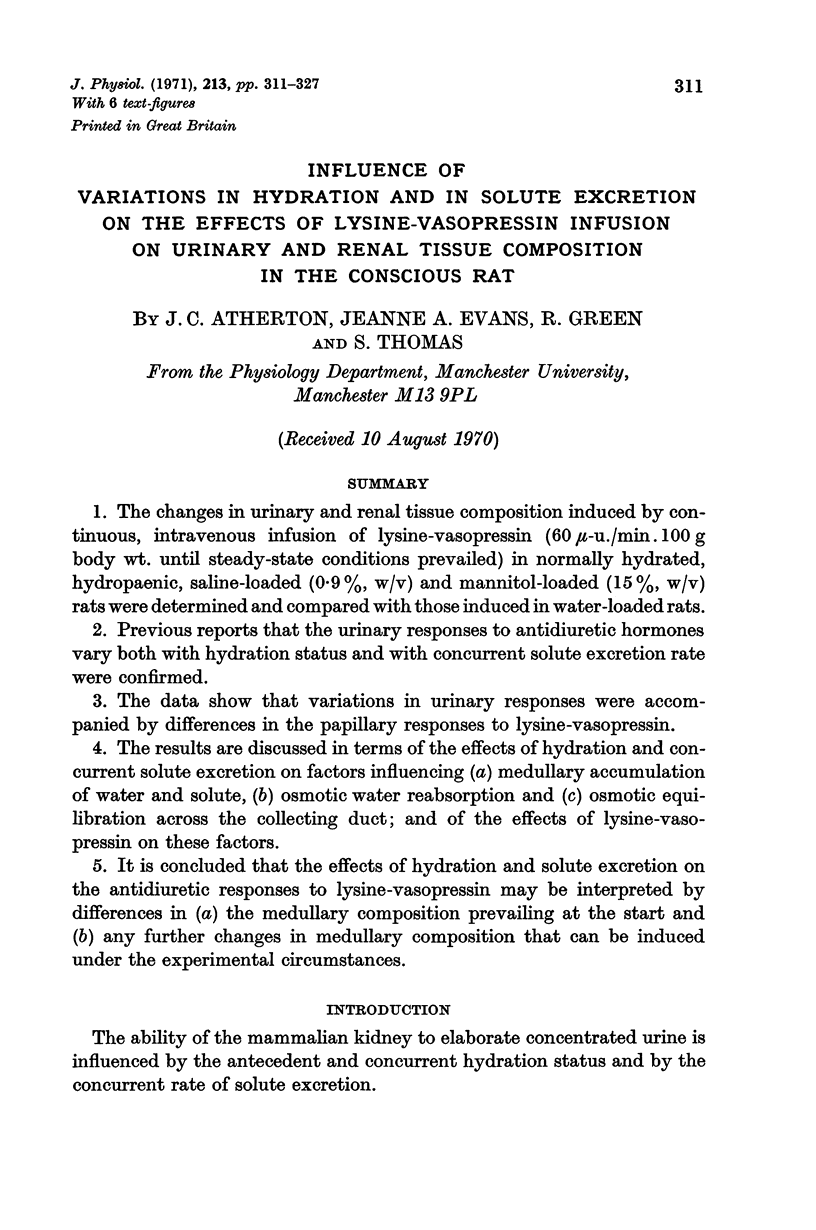
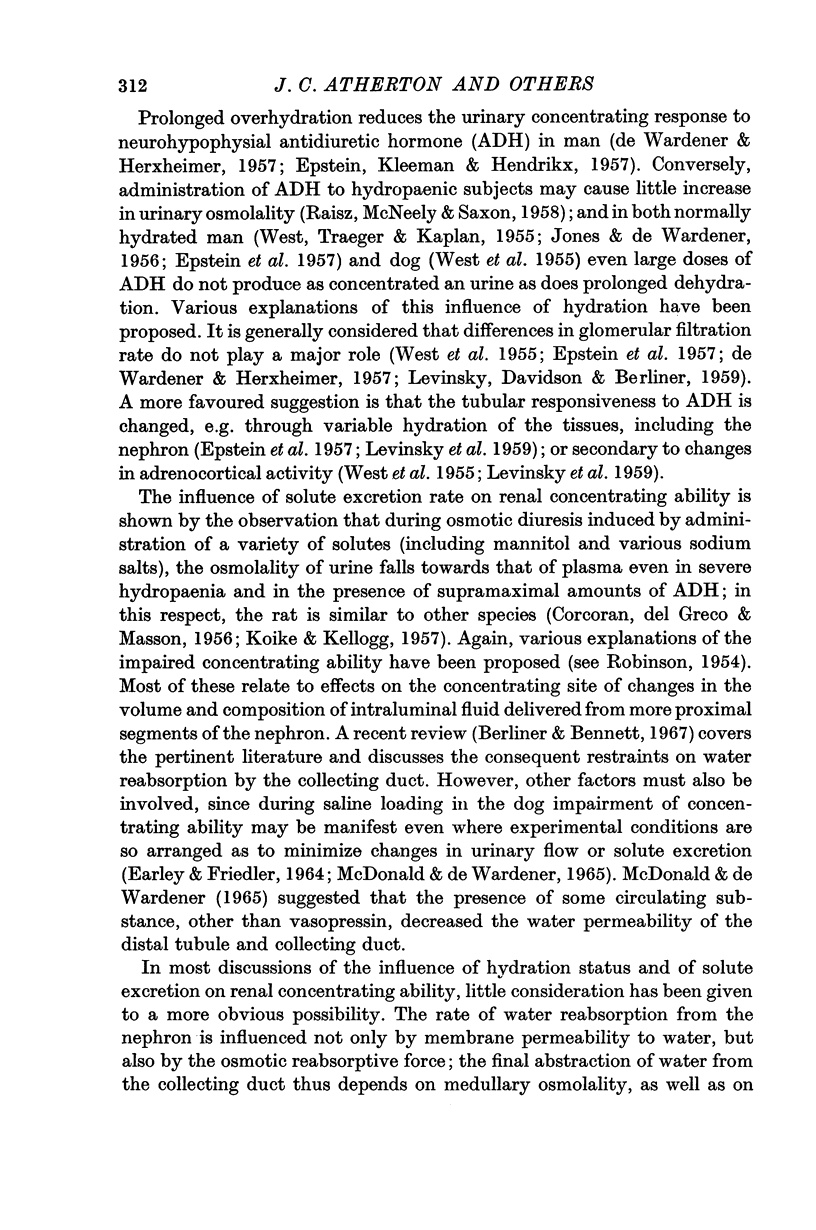

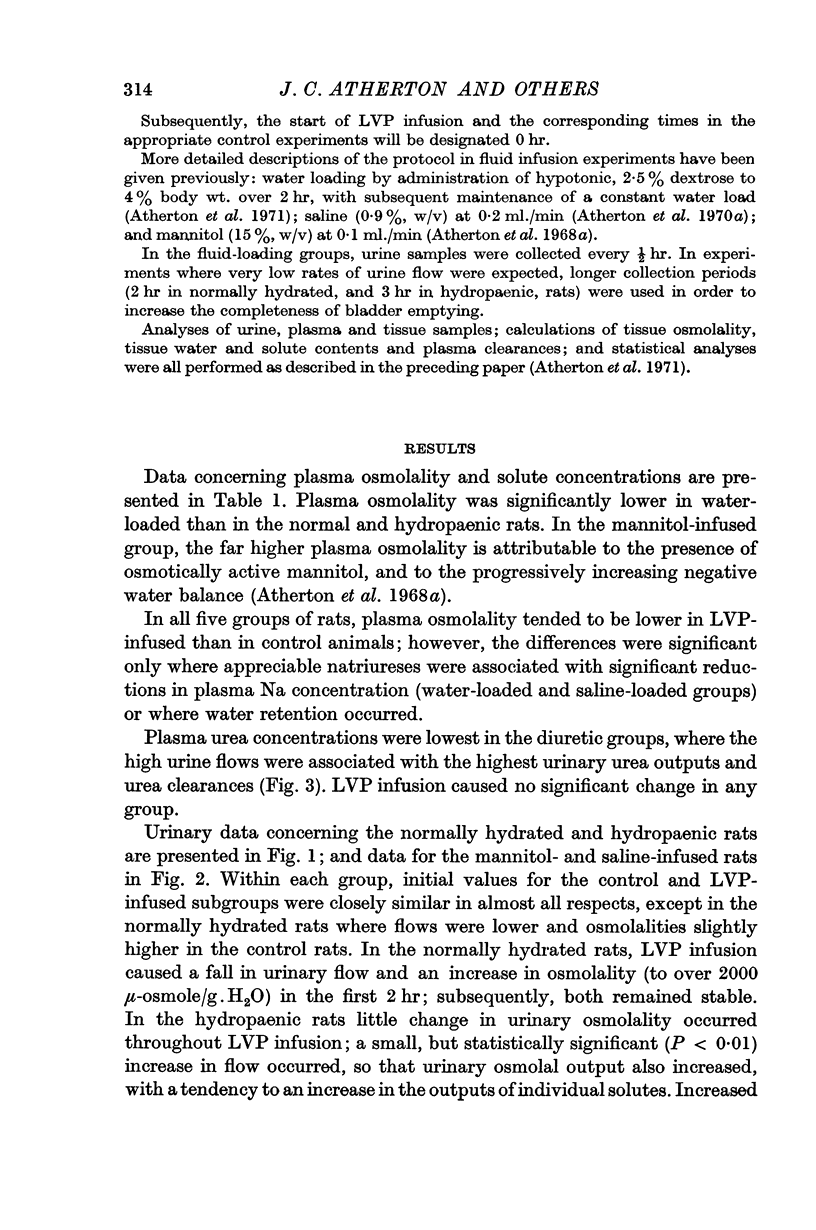


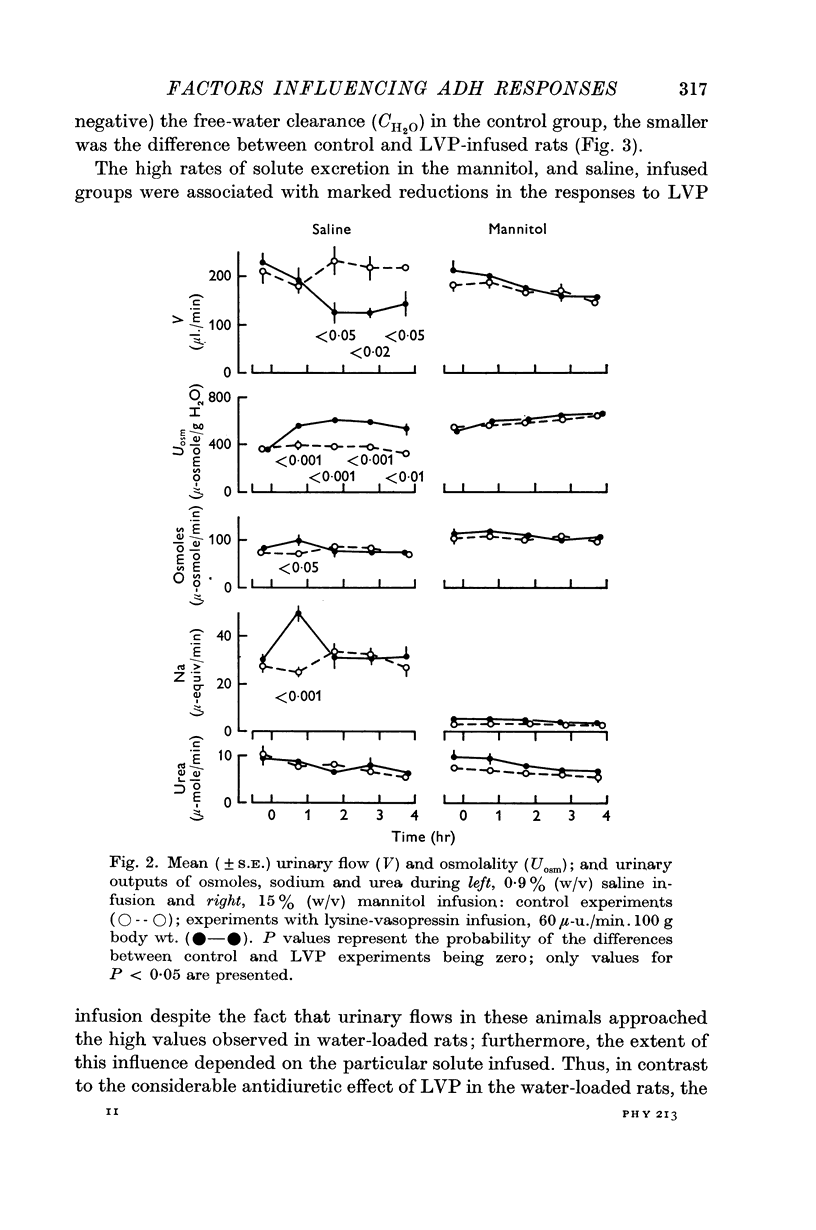
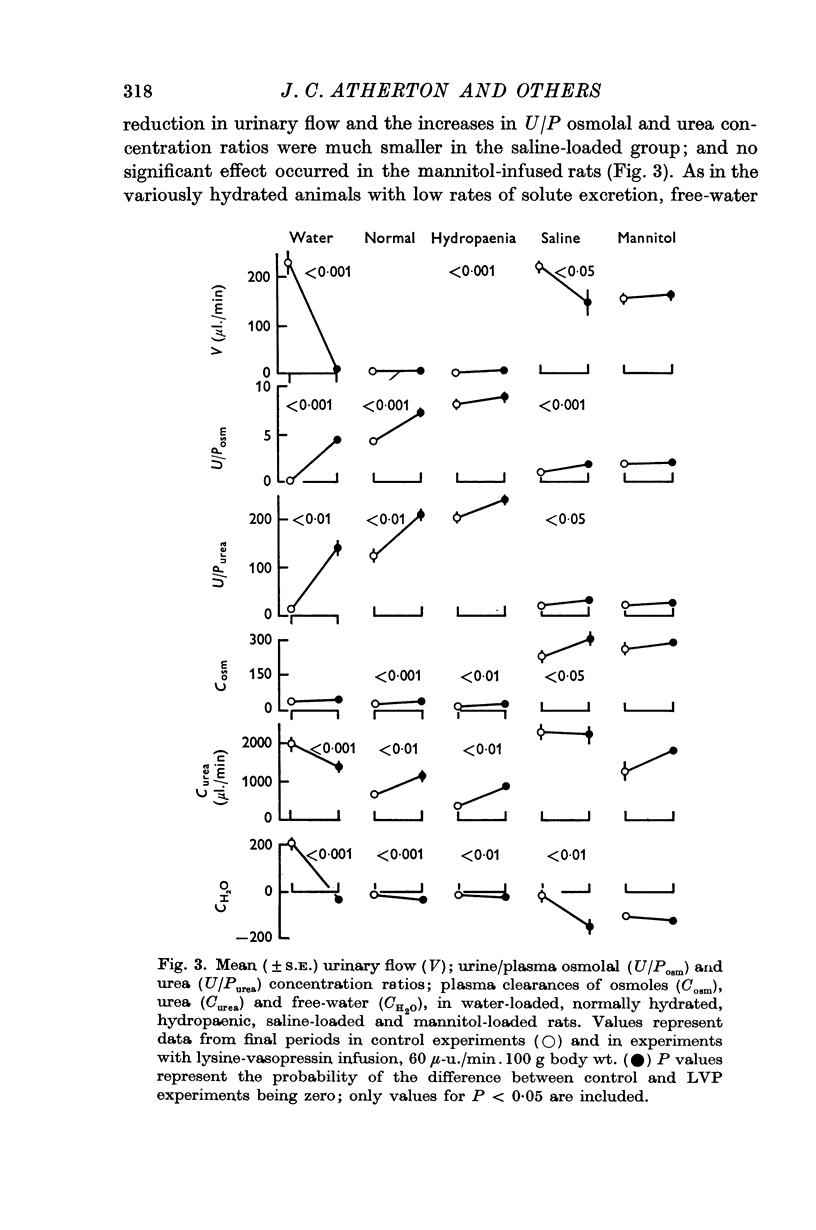

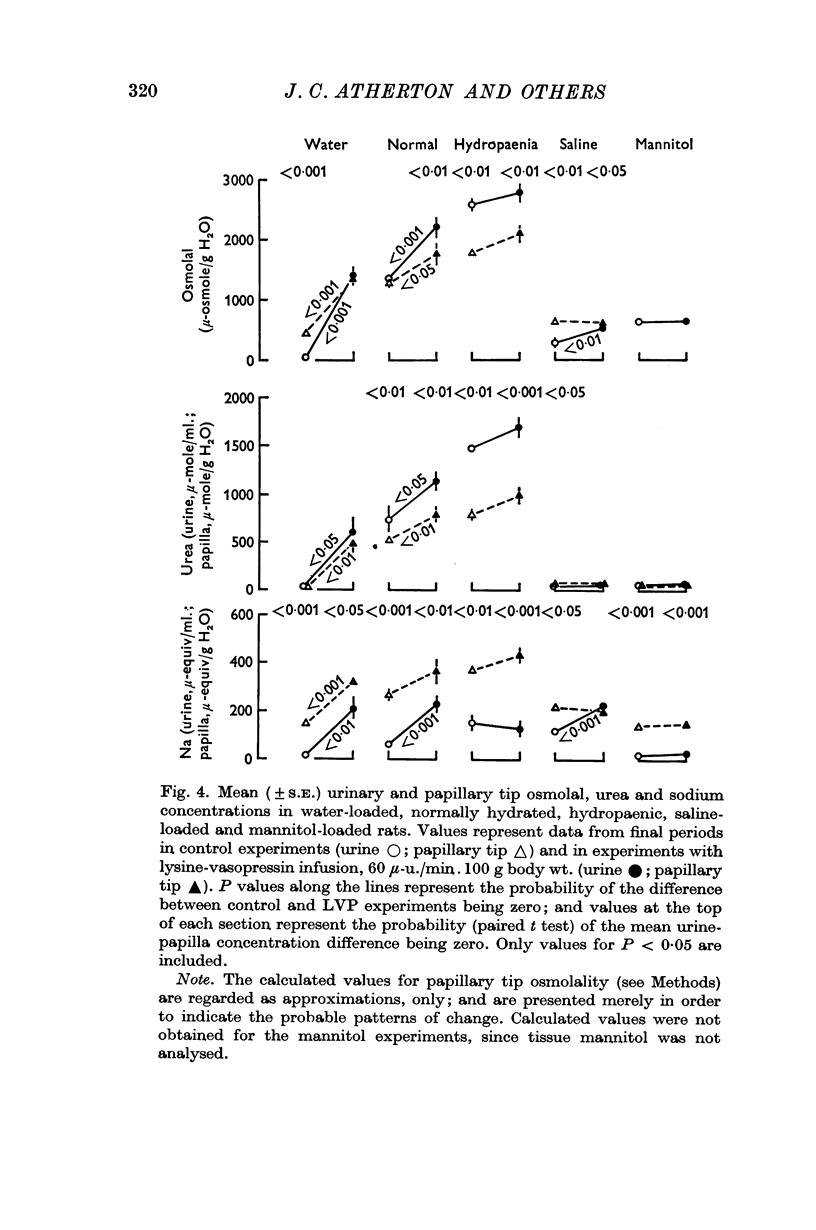
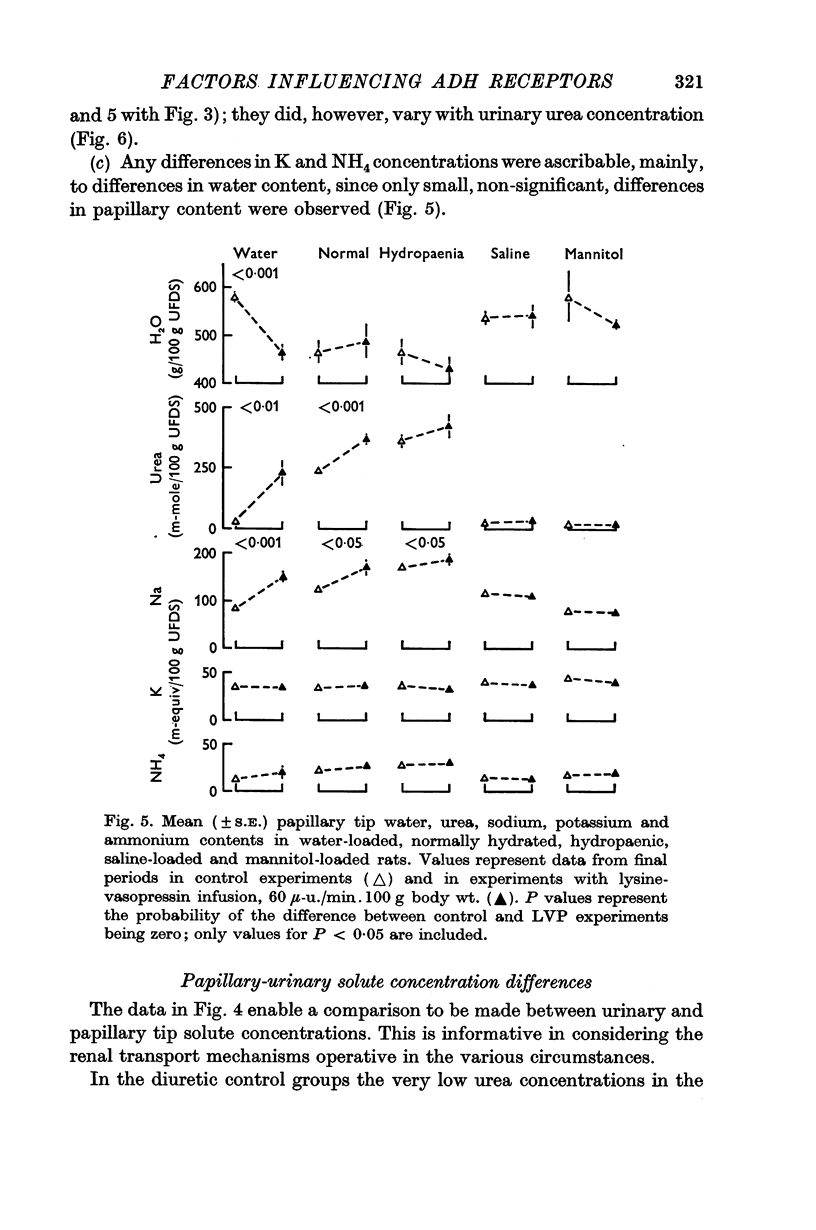
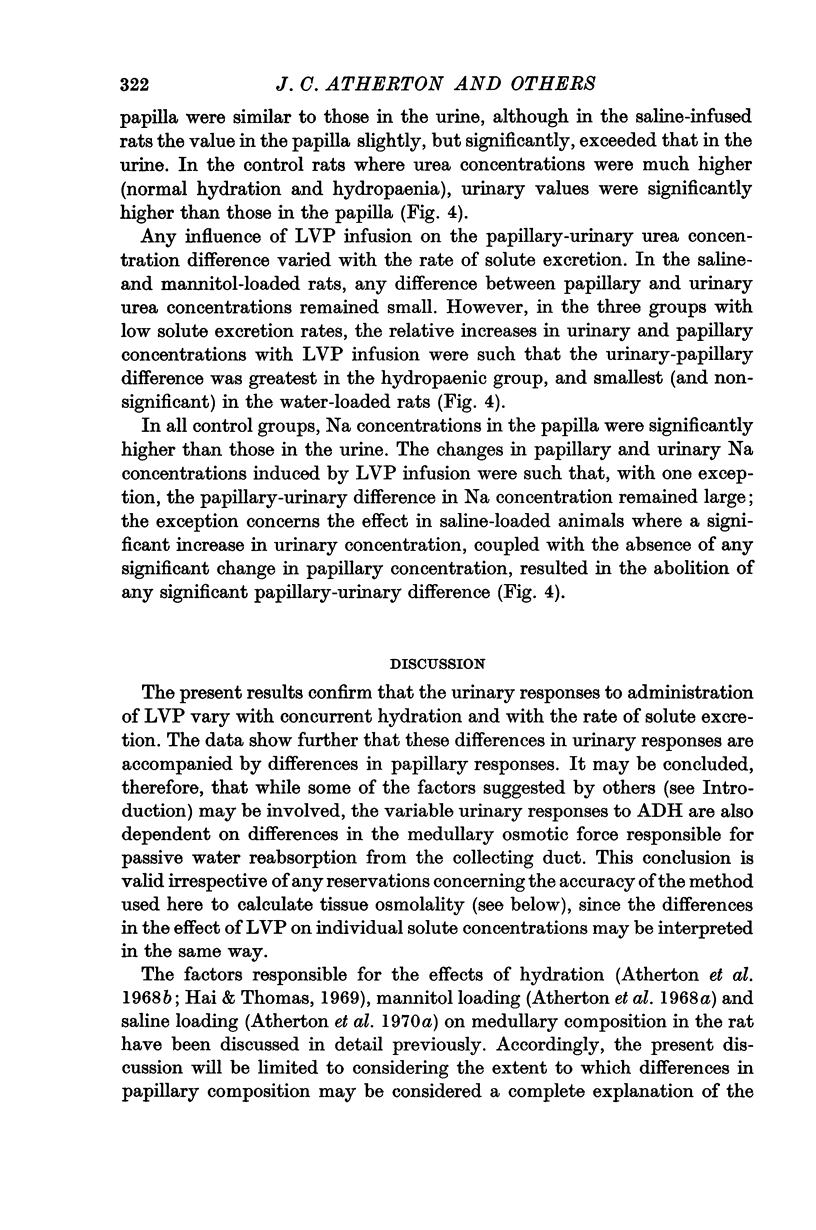
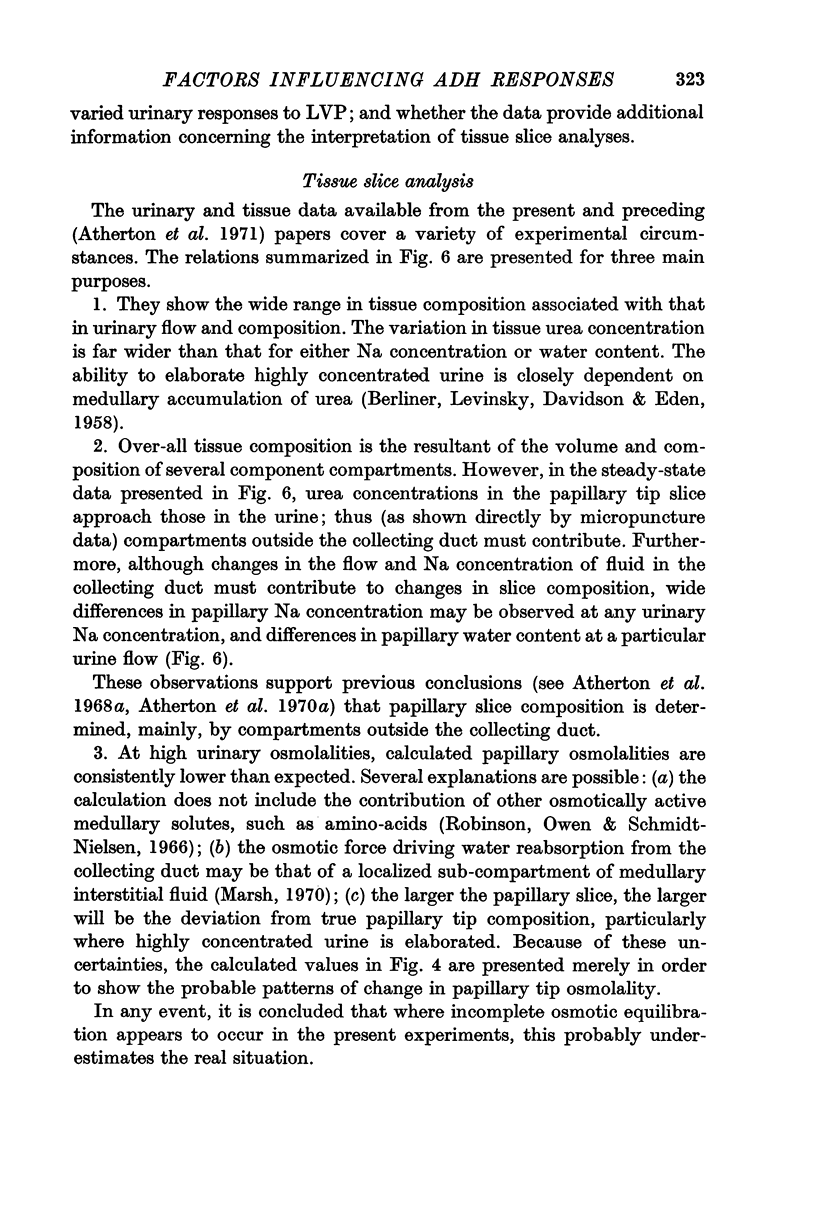
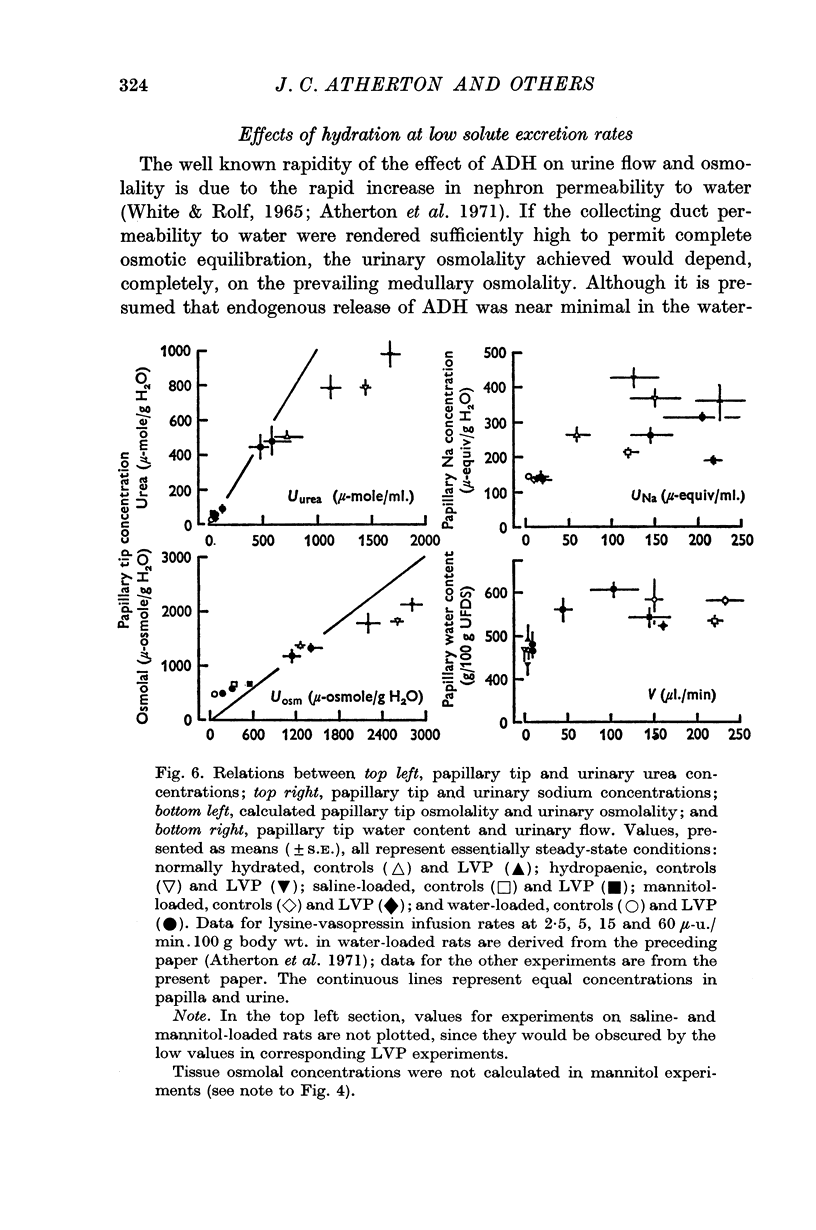

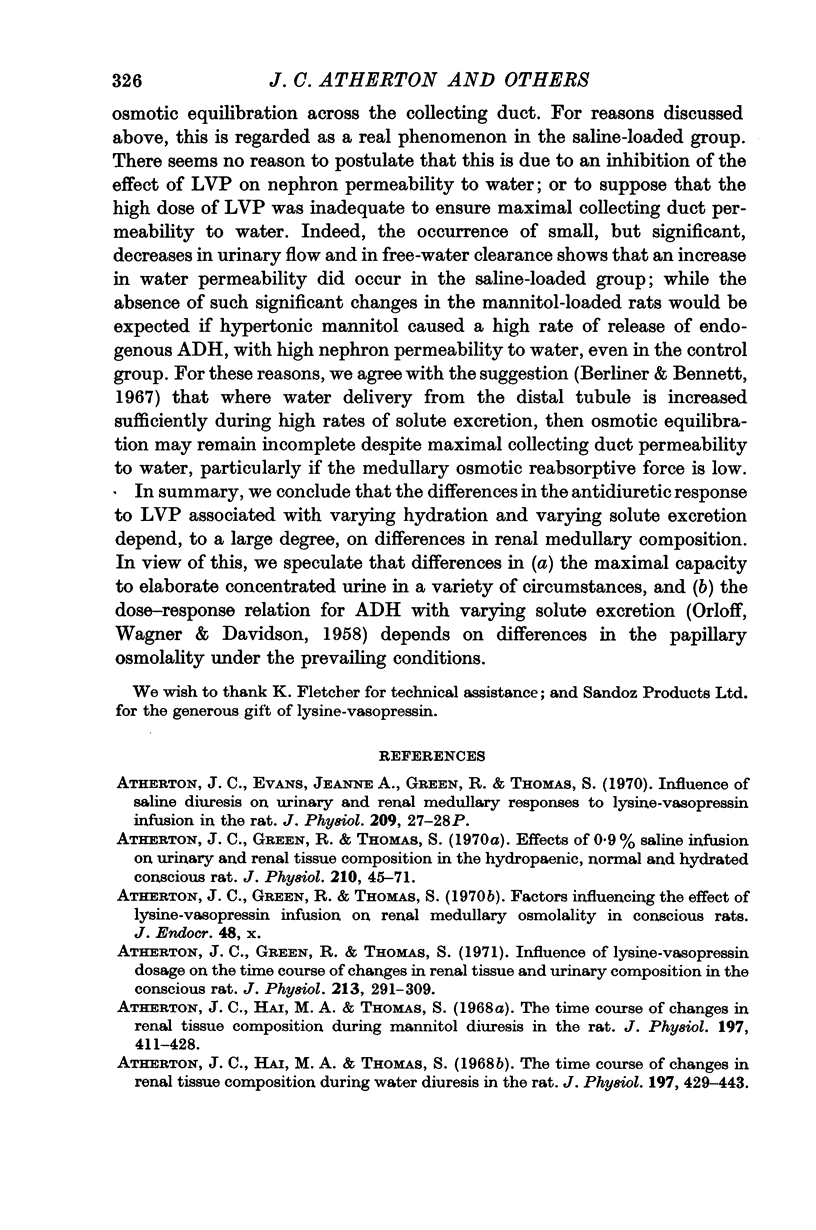

Selected References
These references are in PubMed. This may not be the complete list of references from this article.
- Atherton J. C., Green R., Thomas S. Effects of 0-9 per cent saline infusion on urinary and renal tissue composition in the hydropaenic, normal and hydrated conscious rat. J Physiol. 1970 Sep;210(1):45–71. doi: 10.1113/jphysiol.1970.sp009195. [DOI] [PMC free article] [PubMed] [Google Scholar]
- Atherton J. C., Green R., Thomas S. Factors influencing the effect of lysine-vasopressin infusion on renal medullary osmolality in conscious rats. J Endocrinol. 1970 Sep;48(1):x–xi. [PubMed] [Google Scholar]
- Atherton J. C., Green R., Thomas S. Influence of lysine-vasopressin dosage on the time course of changes in renal tissue and urinary composition in the conscious rat. J Physiol. 1971 Mar;213(2):291–309. doi: 10.1113/jphysiol.1971.sp009383. [DOI] [PMC free article] [PubMed] [Google Scholar]
- Atherton J. C., Hai M. A., Thomas S. The time course of changes in renal tissue composition during mannitol diuresis in the rat. J Physiol. 1968 Jul;197(2):411–428. doi: 10.1113/jphysiol.1968.sp008567. [DOI] [PMC free article] [PubMed] [Google Scholar]
- Atherton J. C., Hai M. A., Thomas S. The time course of changes in renal tissue composition duruig water diuresis in the rat. J Physiol. 1968 Jul;197(2):429–443. doi: 10.1113/jphysiol.1968.sp008568. [DOI] [PMC free article] [PubMed] [Google Scholar]
- BERLINER R. W., LEVINSKY N. G., DAVIDSON D. G., EDEN M. Dilution and concentration of the urine and the action of antidiuretic hormone. Am J Med. 1958 May;24(5):730–744. doi: 10.1016/0002-9343(58)90377-2. [DOI] [PubMed] [Google Scholar]
- Berliner R. W., Bennett C. M. Concentration of urine in the mammalian kidney. Am J Med. 1967 May;42(5):777–789. doi: 10.1016/0002-9343(67)90095-2. [DOI] [PubMed] [Google Scholar]
- CORCORAN A. C., DEL GRECO F., MASSON G. M. Osmotic (mannitol) diuresis in the anesthetized rat; effectiveness of water conserving mechanisms. Am J Physiol. 1956 Dec;187(3):515–519. doi: 10.1152/ajplegacy.1956.187.3.515. [DOI] [PubMed] [Google Scholar]
- DE WARDENER H. E., HERXHEIMER A. The effect of a high water intake on the kidney's ability to concentrate the urine in man. J Physiol. 1957 Nov 14;139(1):42–52. doi: 10.1113/jphysiol.1957.sp005873. [DOI] [PMC free article] [PubMed] [Google Scholar]
- EARLEY L. E., FRIEDLER R. M. CHANGES IN RENAL BLOOD FLOW AND POSSIBLY THE INTRARENAL DISTRIBUTION OF BLOOD DURING THE NATRIURESIS ACCOMPANYING SALINE LOADING IN THE DOG. J Clin Invest. 1965 Jun;44:929–941. doi: 10.1172/JCI105210. [DOI] [PMC free article] [PubMed] [Google Scholar]
- EARLY L. E., FRIEDLER R. M. OBSERVATIONS ON THE MECHANISM OF DECREASED TUBULAR REABSORPTION OF SODIUM AND WATER DURING SALINE LOADING. J Clin Invest. 1964 Oct;43:1928–1937. doi: 10.1172/JCI105067. [DOI] [PMC free article] [PubMed] [Google Scholar]
- EPSTEIN F. H., KLEEMAN C. R., HENDRIKX A. The influence of bodily hydration on the renal concentrating process. J Clin Invest. 1957 May;36(5):629–634. doi: 10.1172/JCI103462. [DOI] [PMC free article] [PubMed] [Google Scholar]
- Hai M. A., Thomas S. Influence of prehydration on the changes in renal tissue composition induced by water diuresis in the rat. J Physiol. 1969 Dec;205(3):599–618. doi: 10.1113/jphysiol.1969.sp008985. [DOI] [PMC free article] [PubMed] [Google Scholar]
- JONES R. V., DE WARDENER H. E. Urine concentration after fluid deprivation or pitressin tannate in oil. Br Med J. 1956 Feb 4;1(4961):271–274. doi: 10.1136/bmj.1.4961.271. [DOI] [PMC free article] [PubMed] [Google Scholar]
- KOIKE T. I., KELLOGG R. H. Osmotic diuresis in the unanesthetized hydropenic rat. Am J Physiol. 1957 Oct;191(1):45–49. doi: 10.1152/ajplegacy.1957.191.1.45. [DOI] [PubMed] [Google Scholar]
- LEVINSKY N. G., DAVIDSON D. G., BERLINER R. W. Changes in urine concentration during prolonged administration of vasopressin and water. Am J Physiol. 1959 Feb;196(2):451–456. doi: 10.1152/ajplegacy.1959.196.2.451. [DOI] [PubMed] [Google Scholar]
- Landwehr D. M., Klose R. M., Giebisch G. Renal tubular sodium and water reabsorption in the isotonic sodium chloride-loaded rat. Am J Physiol. 1967 Jun;212(6):1327–1333. doi: 10.1152/ajplegacy.1967.212.6.1327. [DOI] [PubMed] [Google Scholar]
- MCDONALD S. J., DEWARDENER H. E. SOME OBSERVATIONS ON THE PRODUCTION OF A HYPO-OSMOTIC URINE DURING THE ADMINISTRATION OF 09 PER CENT SALINE AND VASOPRESSIN IN THE DOG. Clin Sci. 1965 Jun;28:445–459. [PubMed] [Google Scholar]
- Marsh D. J. Solute and water flows in thin limbs of Henle's loop in the hamster kidney. Am J Physiol. 1970 Mar;218(3):824–831. doi: 10.1152/ajplegacy.1970.218.3.824. [DOI] [PubMed] [Google Scholar]
- ORLOFF J., WAGNER H. N., Jr, DAVIDSON D. G. The effect of variations in solute excretion and vasopressin dosage on the excretion of water in the dog. J Clin Invest. 1958 Mar;37(3):458–464. doi: 10.1172/JCI103625. [DOI] [PMC free article] [PubMed] [Google Scholar]
- RAISZ L. G., McNEELY W. F., SAXON L. Studies on the renal concentrating mechanism. I. Role of vasopressin. J Lab Clin Med. 1958 Sep;52(3):437–445. [PubMed] [Google Scholar]
- Robinson R. R., Owen E. E., Schmidt-Nielsen B. Intra-renal distribution of free amino acids in antidiuretic ruminants. Comp Biochem Physiol. 1966 Sep;19(1):187–195. doi: 10.1016/0010-406x(66)90559-7. [DOI] [PubMed] [Google Scholar]
- Seely J. F., Dirks J. H. Micropuncture study of hypertonic mannitol diuresis in the proximal and distal tubule of the dog kidney. J Clin Invest. 1969 Dec;48(12):2330–2340. doi: 10.1172/JCI106199. [DOI] [PMC free article] [PubMed] [Google Scholar]
- WEST C. D., TRAEGER J., KAPLAN S. A. A comparison of the relative effectiveness of hydropenia and of pitressin in producing a concentrated urine. J Clin Invest. 1955 Jun;34(6):887–898. doi: 10.1172/JCI103145. [DOI] [PMC free article] [PubMed] [Google Scholar]
- WHITE H. L., ROLF D. URINE AND PAPILLA CONCENTRATIONS DURING TRANSITION FROM HYPOTONIC TO HYPERTONIC URINE. Am J Physiol. 1965 Feb;208:397–400. doi: 10.1152/ajplegacy.1965.208.2.397. [DOI] [PubMed] [Google Scholar]


